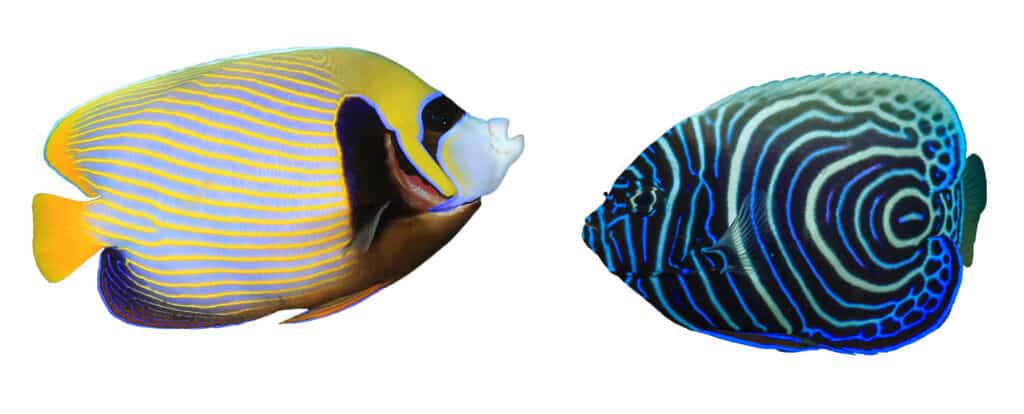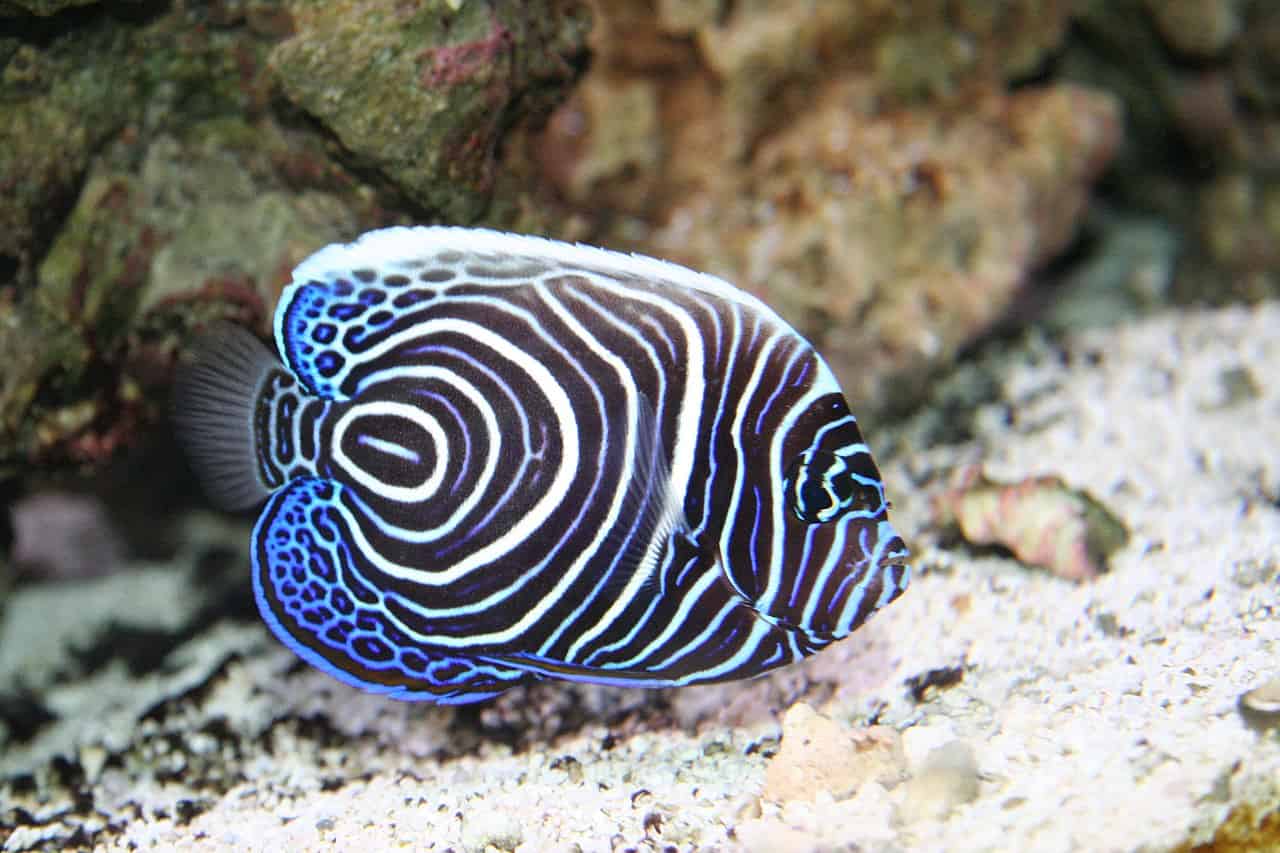Their distinct neon colors allow them to locate other emperor angelfish to mate with
Advertisement
Emperor Angelfish Scientific Classification
- Kingdom
- Animalia
- Phylum
- Chordata
- Class
- Actinopterygii
- Order
- Perciformes
- Family
- Pomacanthidae
- Genus
- Pomacanthus
- Scientific Name
- P. imperator
Read our Complete Guide to Classification of Animals.
Emperor Angelfish Conservation Status
Emperor Angelfish Facts
- Prey
- Tunicates
- Name Of Young
- Juveniles
- Group Behavior
- Solitary
- Fun Fact
- Their distinct neon colors allow them to locate other emperor angelfish to mate with
- Biggest Threat
- Climate change
- Most Distinctive Feature
- Colorful strips
- Other Name(s)
- Imperial angelfish, Imperator angelfish
- Incubation Period
- 2 to 3 weeks
- Age Of Independence
- at birth
- Litter Size
- up to 1000
- Habitat
- Shallow warm tropical seas
- Predators
- Sharks, large fish, marine mammals
- Diet
- Omnivore
- Lifestyle
- Solitary
- Favorite Food
- tunicates
- Slogan
- One of the most beautiful fish on the planet!
- Group
- school
- Nesting Location
- coral reefs
Emperor Angelfish Physical Characteristics
- Color
- Yellow
- Blue
- Black
- White
- Skin Type
- Scales
- Venomous
- No
- Aggression
- Medium
View all of the Emperor Angelfish images!
The emperor angelfish is a species of marine angelfish. This species is commonly found all across the globe, but it is particularly abundant in shallow reefs of the Indian Ocean and Pacific Ocean. This beautiful fish is beloved by divers, marine biologists, and artists alike. First discovered in the 1700s, this remarkable species is a sought-after aquarium fish due to its unique neon stripes.
5 Incredible Emperor Angelfish Facts
- Male and female emperor angelfish can change color during mating or when threatened.
- The shape of an emperor angelfish skull is just as round as its body.
- These small fish can live up to 20 years in the wild!
- Emperor angelfish eat parasites off larger species, acting as cleaner fish.
- They make a clicking or grunting noise when they feel threatened.
Scientific Name
Scientifically known as Pomacanthus imperator, the emperor angelfish was first given the name Chaetodon imperator in 1787 by a German naturalist Marcus Elieser Bloch. They’re classified in the subgenus Acanthochaetodon. The specific epithet imperator in their name means emperor, a name given owing to their colorful and eye-catching appearance. Pomacanthus is a genus of reef fish that primarily lives in the Indian and Pacific oceans. All species of this genus undergo a color transformation when they reach adulthood.
Appearance
The emperor angelfish is a very captivating fish with eye-catching colors. Like many of the world’s most colorful fish, they are found around coral reefs deep in the sea. The reason many reef fish are so colorful is due to an adaptation to allow the fish to identify their own species.
Adult and juvenile emperor angelfish look very different from each other. The juveniles have dark blue bodies covered in light blue and white stripes. They also have a transparent caudal fin. Conversely, adult emperor angelfish have yellow and blue horizontal stripes all over their bodies. Their face is light blue, with eyes surrounded by a dark blue margin. They have a yellow caudal fin.
In terms of their size, these fish can grow up to 16 inches, which is about the diameter of a large-sized pizza. However, it is rare to find an emperor angelfish this big. They generally average from 10 to 15 inches long. They have 13 to 14 spines in their dorsal fin and 3 in their anal fin.

Adult emperor angelfish look so different from juvenile emperor angelfish they were thought to be an entirely different species until the 1930s!
©Rich Carey/Shutterstock.com
Behavior
The emperor angelfish is a solitary fish that prefers to wander the shallow reefs on its own. In fact, they are generally territorial, and when they see other emperor angelfish, they tend to drive them away by chasing them.
Male emperor angelfish are especially aggressive and will defend their territory. This is why two males should never be kept in the same tank. They take time to adjust to new environments and can be shy at first. But once they have adapted, they become more active.
When threatened, they let out a grunting sign as an auditory cue that they are in distress.
Habitat
The emperor angelfish is found in the Indian and Pacific oceans, usually anywhere between 3 to 350 feet under the sea. They thrive in the warm tropical waters near the equator with temperatures of around 72 to 82 degrees Fahrenheit (or 22 to 28 degrees Celsius). They’re often seen near coral and seaweed and frequently hide in reef cavities. They also live in caves or ledges close to any coral reef colony. As juveniles, they often hide in semi-covered, rocky areas in or around ledges on the seabed.

Emperor angelfish (
Pomacanthus imperator) are often seen near coral and seaweed and frequently hide in reef cavities.
©Rich Carey/Shutterstock.com
Emperor Angelfish Diet
The emperor angelfish is an omnivore that will eat just about anything it comes across. Its diet is primarily based on small invertebrates and plants, but it is also known to be a cleaner fish that eats parasites and scraps off of larger fish.
Who eats the emperor angelfish?
Being smaller fish, emperor angelfish are preyed on by larger reef animals such as sharks, larger carnivorous fish, and even marine mammals such as dolphins and whales.
What does the emperor angelfish eat?
As mentioned above, the diet of an emperor angelfish is based on small invertebrates such as tunicates. They also feed on plants and like to eat algae and sponges found around coral reefs. Emperor angelfish rarely venture far to find food, but the species can swim long distances to find its food if needed.
Emperor Angelfish Predators and Threats
Emperor angelfish are likely preyed on by common reef predators such as blacktip reef sharks, blue sharks, and marine mammals such as dolphins and whales. Overall, any omnivorous or carnivorous species in the ocean larger in size than the emperor angelfish might be a potential predator.
Other threats to the survival of the emperor angelfish are humans. Owing to their beauty, these fish are sought after and captured to be kept in aquariums or as pets. But fully grown emperor angelfish take a long time to acclimate to their new environment if captured. In addition, they do not generally breed in captivity because aquariums cannot mimic their natural habitat. For this reason, if an emperor angelfish must be kept in captivity, starting with a juvenile is recommended to allow it to acclimate.
Other factors, such as coral bleaching, warming ocean temperatures, and overfishing, pose potential threats to all reef animals, including the emperor angelfish. At present, their conservation status is Least Concern, but many marine animals are expected to begin declining in population as the effects of climate change set in more and more.

Emperor angelfish feed on plants and like to eat algae and sponges found around coral reefs.
©Rich Carey/Shutterstock.com
Emperor Angelfish Reproduction
During the mating season, both males and females begin to circle each other close to the water’s surface. After a while, the male releases the sperm, and the female releases the egg to start the fertilization process, which occurs externally.
The female then lays the eggs, which drift away by the water current. This only happens once a year. Around a thousand eggs are laid by an emperor angelfish female, which then spread all over the water. The eggs become larvae in a few weeks and hatch. Then within the following few weeks, they become small fish that grow into juvenile emperor angelfish.
There has not been a single instance of emperor angelfish breeding in captivity. They would require enormous aquariums and perfect conditions to mate in captivity, so it is practically impossible.
Emperor Angelfish Babies
Emperor angelfish babies are called juveniles. As juvenile emperor angelfish, their bodies continue to undergo changes until they become fully grown adults. This takes up to two years, after which these juveniles will have the same color as the adult fish.
For a long period, emperor angelfish juveniles were thought to be a completely different species owing to their patterns and colors, which are very distinct from the adults. In the 1930s, biologists discovered that they were the same animals. The mother plays no maternal role toward the young. In fact, mothers might not even know who or where their young are, because once the eggs hatch, the fish fend for themselves entirely. So the juveniles are equipped to protect themselves from predators from birth.
Juvenile emperor angelfish live by the rocks of the reef and move into the reefs as they age, and finally, they live in the coral as adults.

Juvenile emperor angelfish bodies continue to undergo changes until they become fully grown adults, typically up to two years.
©Vic Brincat (cadmanof50s) from Keswick, Ontario, Canada, CC BY 2.0, via Wikimedia Commons – License
Emperor Angelfish Lifespan
Emperor angelfish can live as long as 20 years, but this fish is less likely to live as long in captivity. With that said, with proper care and conditions, emperor angelfish in captivity could live as long as 20 years. Unfortunately, these fish are susceptible to several diseases as they age. Among these, the common ones include:
- White Spot Disease – also called Ichthyophthirius multifiliis or just “lch”, this is a potentially fatal parasitic infection where the parasite enters the fish’s body through the dorsal fins.
- Marine Velvet – another parasite infection where the fish becomes covered in gold, velvet-looking patches.
- Head and Lateral Line Erosion Disease – the exact reason for this disease is unknown, but it is commonly found in older emperor angelfish. It’s theorized that providing the fish with more light can mitigate the symptoms.
Emperor Angelfish Population
The exact number of species all over the world is unknown. However, these fish are not in danger or at risk of extinction. Hence, their conservation status is Least Concern.
Emperor Angelfish in Zoos
Emperor Angelfish are commonly found in zoos and aquariums around the world. You can go visit them in some of the following zoos in the USA.
Related Animals
View all 117 animals that start with EEmperor Angelfish FAQs (Frequently Asked Questions)
Are emperor angelfish carnivores, herbivores, or omnivores?
Emperor angelfish are omnivorous fish that feed on plants and small invertebrates alike.
Are emperor angelfish hard to keep as pets?
Yes. Though emperor angelfish are popular seawater fish to keep as pets, these fish are deceptively difficult to look after. As these fish are found at depths of up to 300 feet in the ocean, they need habitats that mimic the underwater environment, which is often tough in a small saltwater aquarium.
What are some fish that the emperor angelfish is mistaken for?
The emperor angelfish is often mistaken for other species of angelfish, such as the lemonpeel angelfish, regal angelfish, and the flame angelfish.
How do emperor angelfish communicate with one another?
Not much is known about their communication. However, when threatened or angry, these fish let out a clicking or grunting noise. Angelfish are also known to send chemical signals in the water through their urine.
How fast can an emperor angelfish swim?
This species of angelfish is not a very fast swimmer, but their swimming speed has not been officially measured.
What tank size is suited to keep a pet emperor angelfish?
These territorial fish can often mark territory as large as 10,000 square feet. That’s bigger than most houses in Manhattan! This obviously isn’t easy to replicate for the average home aquarium. So about 125-200 gallons of water is recommended if you have a juvenile emperor angelfish andat leastt 220 gallons if you have an adult.
What do emperor angelfish like to eat?
The preferred diet of an emperor angelfish consists of sponges and algae.
How big does an emperor angelfish get?
On average, an emperor angelfish will generally get to be 10 to 15 inches long. But some bigger fish can grow to be as long as 16 inches!
Thank you for reading! Have some feedback for us? Contact the AZ Animals editorial team.
Sources
- FishBase, Available here: https://www.fishbase.de/summary/6504
- National Aquarium, Available here: https://aqua.org/explore/animals/emperor-angelfish
- Aquarium Source, Available here: https://www.aquariumsource.com/emperor-angelfish/
- LiveAquaria, Available here: https://www.liveaquaria.com/product/411/?pcatid=411
- Istanbul Akvaryum, Available here: https://www.istanbulakvaryum.com/en/creatures/emperor-angelfish
- The Spruce Pets, Available here: https://www.thesprucepets.com/emperor-angelfish-species-profile-4772931
- Australian Museum, Available here: https://australian.museum/learn/animals/fishes/emperor-angelfish-pomacanthus-imperator/
- Kidadl, Available here: https://kidadl.com/facts/animals/emperor-angelfish-facts

















